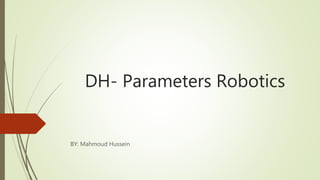
Dh parameters robotics
- 1. DH- Parameters Robotics BY: Mahmoud Hussein
- 2. Examples
- 3. Examples
- 4. Examples
- 5. Examples
- 6. Examples
- 7. Examples
- 14. Steps
- 15. Steps
- 16. Example
- 17. Robot specification But in addition to classification, there are several additional characteristics : (i)Number of axes (ii)Load carrying capacity (kg) (iii)Maximum speed (mm/sec) (iv)Reach and stroke (mm) (v)Tool orientation (deg) (vi)Precision, accuracy and Repeatability of movement (mm) (viii) Operating environment 17
- 18. Number of Axes The industrial robots have got a number of axes about which its various links rotate or translate. the first three axes of the robot called major axes are used to establish the position of the wrist. The remaining axes of the robot are used to establish the orientation of the robots wrist, called minor axes . Thus a six axes robot is a general manipulator which can move its end effector to both an arbitrary location and an arbitrary orientation with in its work volume. 18
- 19. Some industrial robots have more than six axes, termed as the redundant axes , which are generally used to avoid certain obstacle in the robots work volume. The mechanism to activate the robot tool (end effector), or the opening and closing of the robots gripper, is not considered as the independent robot axis, as this mechanism (axis) do not contribute to acquire either the position or the orientation of the end effector in robots working space. 19
- 20. Load Carrying Capacity: The load carrying capacity is mainly determined by various factors : robot’s size, configuration, type of drive system and the type of application for which it is designed. A very wide range: from few grams to several thousand of kilograms. The maximum load carrying capacity should be specified for the condition that it is in its weakest position. It is the position when the robots arm is at maximum horizontal extension. 20
- 21. The specification provided by manipulator manufacturers is actually the gross weight capacity that can be put at the robotic wrist. Thus to use this specification the user must know weight of the end effector. E.g., if the gross load carrying capacity of a robot is 10.0 kg and it’s end effector weigh 3.0 kg, then the net load carrying capacity of the robot would be only 7.0 kg. 21
- 22. The maximum tool tip speed of the robots is from a few mm per second to several meters per second. The speed of the robot is measured at robot’s wrist. Thus the highest speeds can be achieved with maximum horizontal extension of arm away from the base of the robot. Also the type of the drive system affects the joint speeds, e.g. the hydraulic robots are having faster joint motions than the electrical drive robots. Maximum Speed of Motion 22
- 23. A meaningful measure of the robot speed is the cycle time, which is the time required to perform several periodic motions of robot. As it is desirable for any production operation to minimize the cycle time of task, most of robots have the provision to regulate or adjust the speed. 23
- 24. Reach and Stroke: Reach and stroke of the robot are the measure of the work volume of the robot. The horizontal reach: it is the maximum radial distance at which the robotic wrist can be positioned away from the vertical axis about which the robot rotates, or the base of the robot. The horizontal stroke: it is the total radial distance the wrist can move. There is always a certain minimum distance the robot’s wrist will remain away from the base axis. 24
- 25. Thus, the horizontal stroke is always less than equal to the horizontal reach. For a cylindrical coordinate robot the horizontal reach is the outer cylinder of the workspace, while the horizontal stroke is the difference between the radii of the concentric outer cylinder and the inner cylinder, as shown in figure 1.10 25 r
- 26. The vertical reach: is the maximum vertical distance above the working surface that can be reached by the robot’s wrist. The vertical stroke: is the total vertical distance that the wrist can move. the vertical stroke is also always less than equal to the vertical reach. articulated robot have full work envelope means stroke equal to reach But necessary to program to avoid collision with itself or work surface. 26
- 27. Tool Orientation The three major axes of the robot determine the work volume, while remaining additional axes of the robot determine the orientation of the robot’s end effector. If three independent minor axes are present then the end effector will able to achieve any arbitrary orientation in the three dimensional work volume of the robot. the three axes associated with the wrist are called as yaw- pitch and roll which are used to define the orientation of end effector of robot. 27